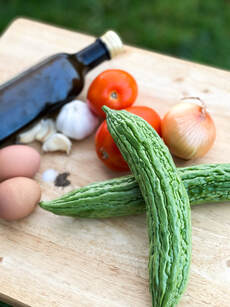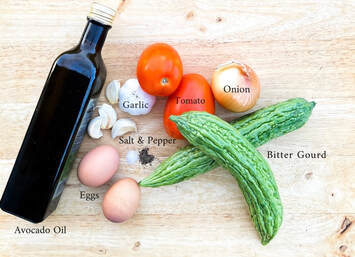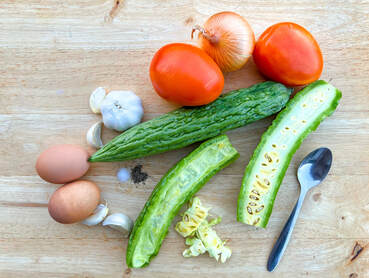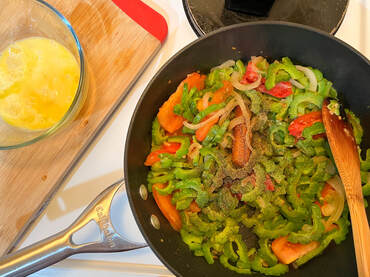 It’s 2023, and it’s time to ring out the old and bring in the new. As you embark on new beginnings, you will be surprised by how stories unfold and the goodness life has in store for you as you open up to trying new things and creating new goals. I think the world should celebrate more on the dates that we made changes and not just the fact that a year changes. That being the case, I hope you’re open to trying new things, embracing changes, learning, and living. I’m starting mine by spreading positivity and “GOURD” vibes all the way by learning about foods from different cultures and, at the same time, sharing my own. See what I did there with the “GOURD”? Let me share with you this humble vegetable-fruit called Bitter Gourd, which is not quite as famous and well-used here compared to where I came from, the Philippines. Keep reading as I will share tips on getting rid of the bitterness to make it a much BETTER gourd for you! What is Bitter Gourd? Bitter Gourd, also known as bitter melon, balsam pear, karela (in India), ampalaya (in the Philippines) or its scientific name Momordica charantia — a tropical vine of Cucurbitaceae, otherwise known as the gourd family. It belongs to the same family as squashes like zucchini and pumpkins, melons, and cucumbers. This plant thrives in both subtropical and tropical areas, including Asia, the Caribbean, South America, and some parts of Africa. Despite having a variety of names worldwide, two things remain consistent with this vegetable-fruit:
Did you know that Bitter Gourd... Is a rich source of vitamin C, which boosts your immune system, aids in decreasing inflammation, and promotes wound healing. It also provides folate, which is crucial for growth, development, and red blood cell formation. It also contains significant amounts of:
And if you’re still not impressed with this ingredient..
It's “gourd” for your…
Let the bitterness subside
 Stir-Fry Bitter Gourd Ingredients: 2 pieces bitter melon, cleaned & thinly sliced 4 cloves minced garlic ½ yellow onions, sliced 2 tomatoes, sliced into quarters 2 tablespoon avocado oil 2 raw & beaten eggs ½ tsp salt ½ tsp ground black pepper Directions: Soak the bittermelon with salt and water in a large bowl, then leave for 5 minutes. After 5 minutes, place the bitter melon in a cheesecloth, then squeeze tightly to drain excess liquids. Once the pot is heated, add the avocado oil and sauté garlic, onion, and tomato until translucent and fragrant. Add the bitter melon, give it a quick stir, then add salt & pepper to taste. Beat the eggs and pour over the bitter melon, then wait till the egg is partially settled before mixing. Serve hot, and enjoy! Optional: Add ground pork, beef, chicken, shrimp, or tofu to elevate this simple dish. Makes 4 servings Nutrition per 1 cup: 120 calories; 9.7 Fat; 3.6g Protein; 4.64g Carbohydrates; 1.2g Fiber; 103mg Sodium Incorporating Bitter Gourd is a great way to improve your eating habits this year; a low-calorie ingredient that retains the most helpful nutrients your body needs.
This is the only bitter taste you’ll ever need and a low-cost way to boost your health! Zamaira Chan, Dietetic Intern References: US Department of Agriculture. Bitter melon. Food Data Central, US Department of Agriculture. March 19, 2021. Accessed February 15, 2023. https://fdc.nal.usda.gov/fdc-app.html#/food-details/1548192/nutrients Clardy AE, Crudup S. Bitter melon. Tennessee State University Extension. Accessed February 18, 2023. https://www.tnstate.edu/extension/documents/Bitter%20melon%20fact%20sheet.pdf Silver N. Bitter melon and diabetes. Healthline. January 2018. Updated February 24, 2021. Accessed February 15, 2023. https://www.healthline.com/health/diabetes/bitter-melon-and-diabetes Diabetes co. Bitter melon and diabetes. Diabetes.co.uk the global diabetes community. January 2019. Updated January 25, 2023. Accessed February 15, 2023. https://www.diabetes.co.uk/natural-therapies/bitter-melon.html Elekofehinti OO, Ariyo EO, Orimoloye M, et al. Potential use of bitter melon (Momordica charantia) derived compounds as antidiabetics: In silico and in vivo studies. Pathophysiology. 2018;25(4):327-333. DOI: 10.1016/j.pathophys.2018.05.003
0 Comments
Leave a Reply. |
SD BlogA place for our consultant Registered Dietitian Nutritionists (RDNs) to share nutrition science, yummy and healthy recipes, tips on seasonal ingredients, and other nutritional musings. Enjoy! Categories
All
Archives
May 2024
|




 RSS Feed
RSS Feed